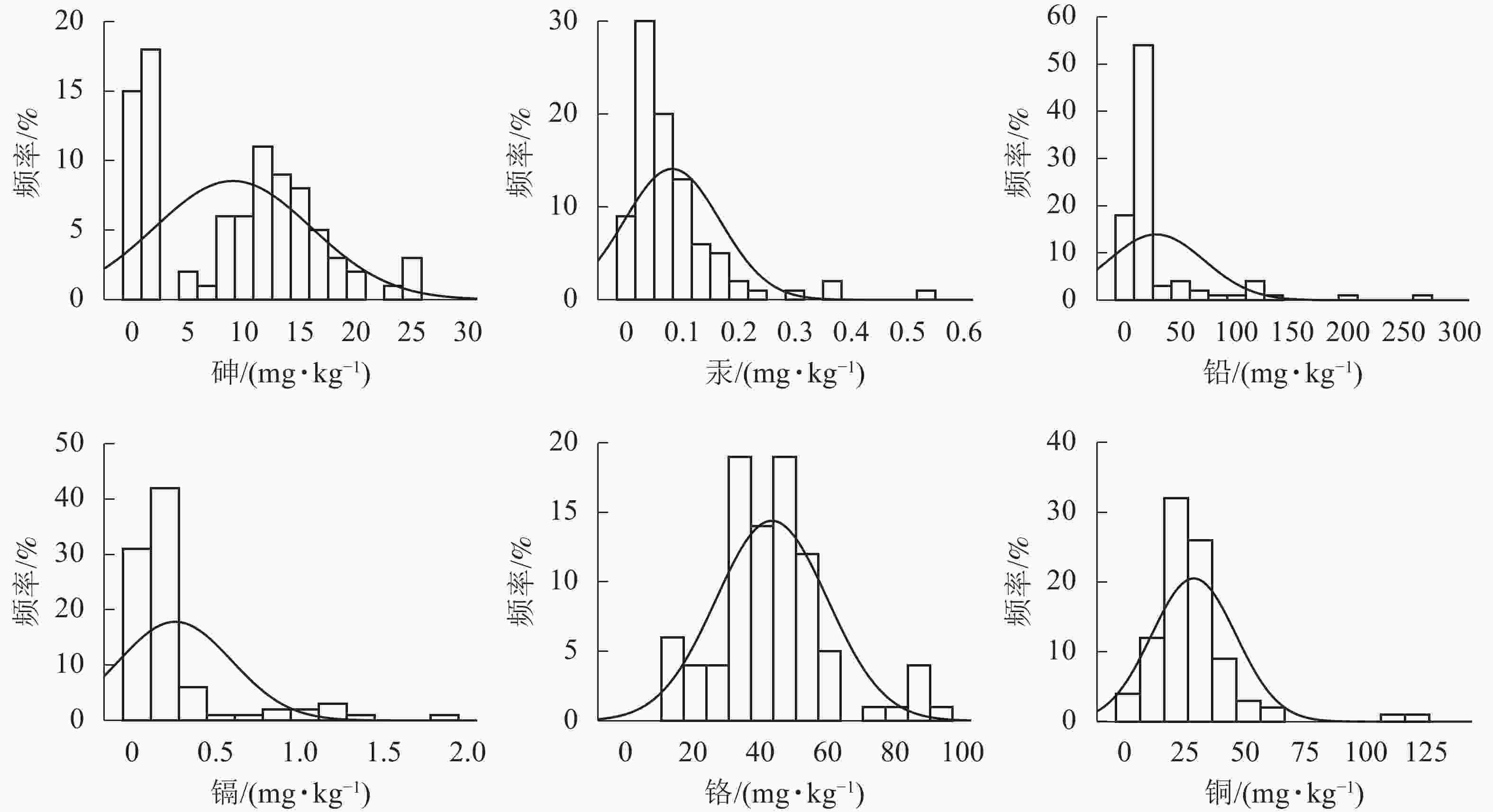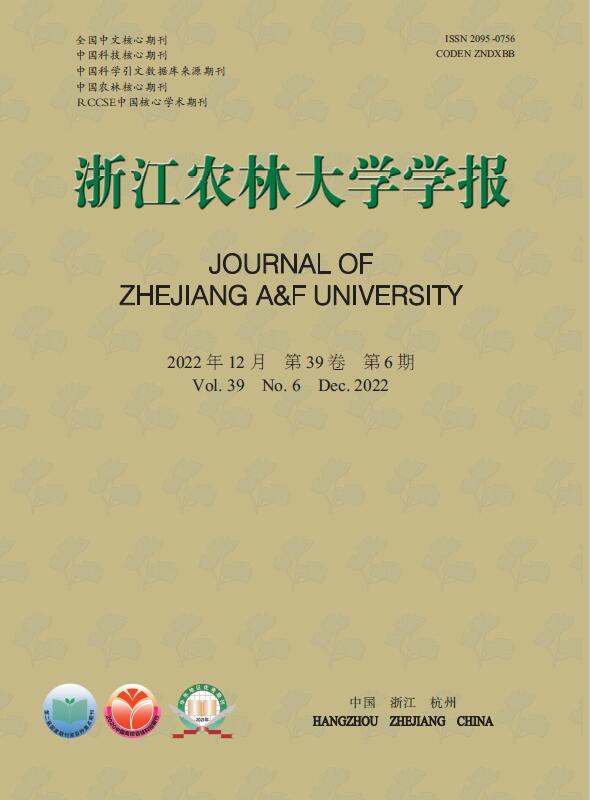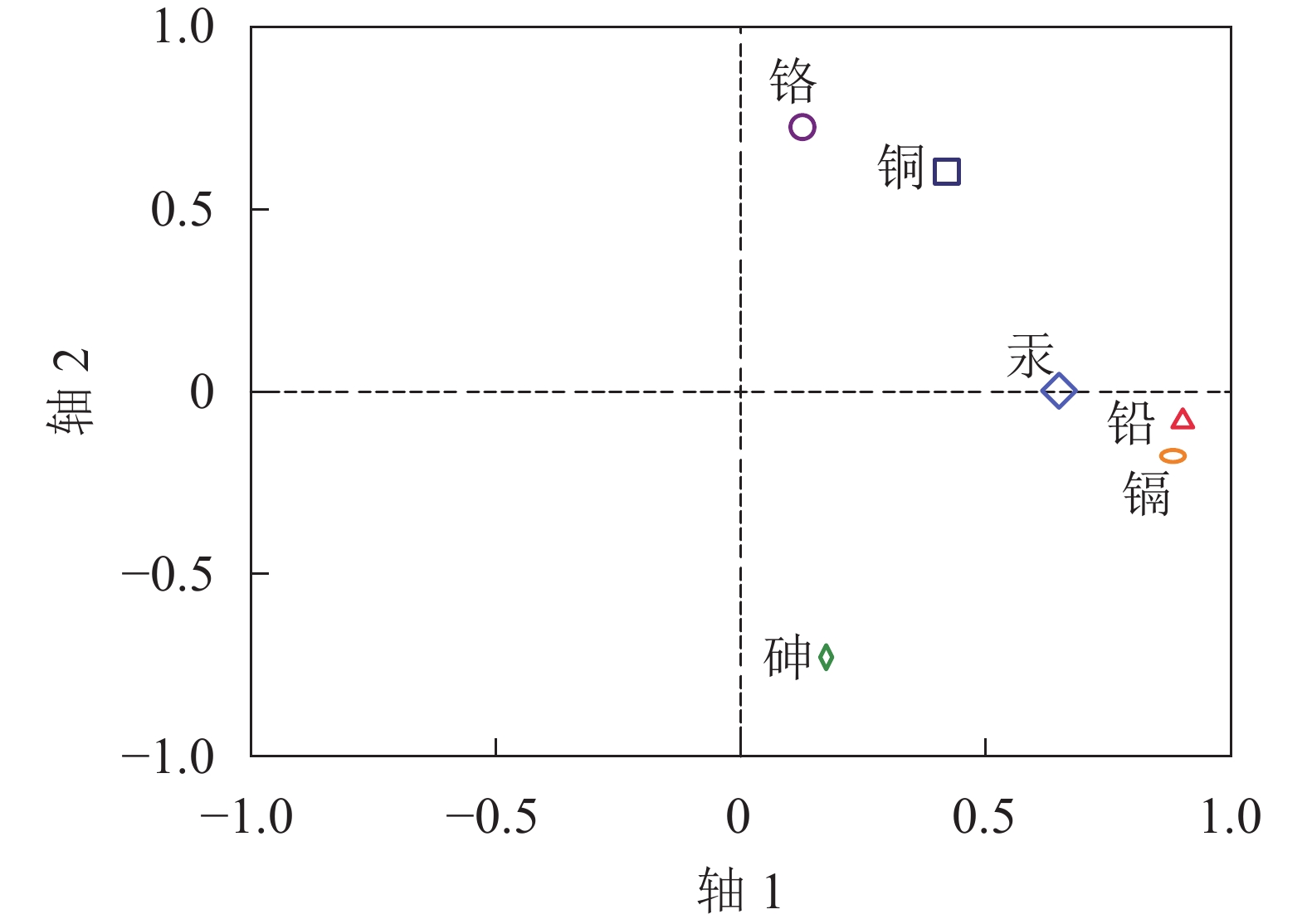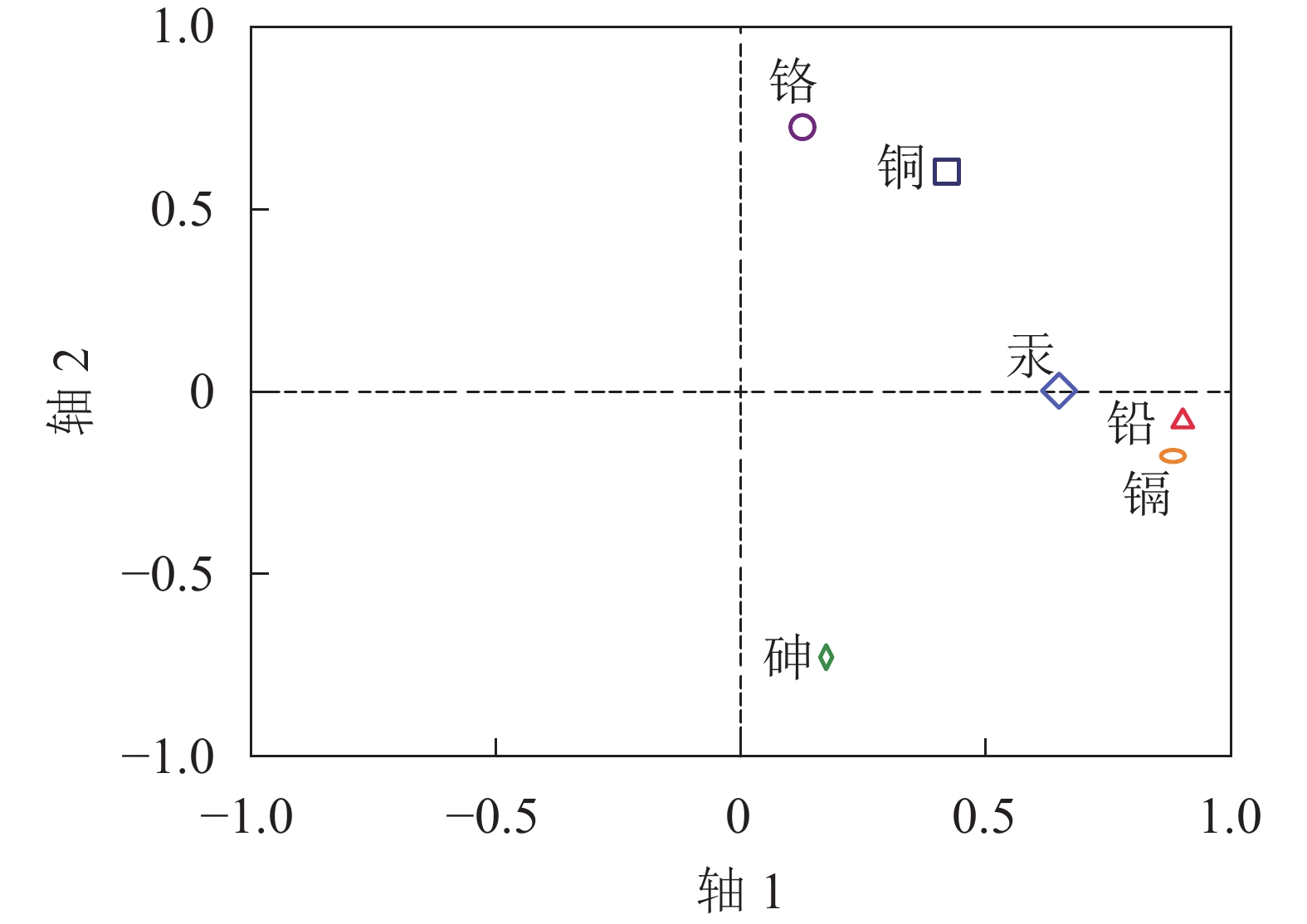-
近年来,人类对土地和矿物资源的过度开发利用以及对农药和化肥的不合理使用,破坏了原生态土壤[1-2],引起了土壤质量严重下降,甚至导致了土壤污染,其中重金属是土壤污染的主要来源之一[3]。农田中土壤重金属具有潜伏性强、难去除、毒害性高等特点,不仅可以通过积累影响土壤和农产品质量,阻碍植物生长,还可以通过食物链被人体吸收,威胁人体健康[1, 4]。果园土壤作为生产果品的载体,其中有毒有害重金属不仅会对树体生长和果实产量产生影响,而且会影响果品质量安全并带来生态风险。
麦尔哈巴·图尔贡等[5]研究发现:镉是吐鲁番盆地葡萄Vitis vinifera种植园土壤中污染水平及生态风险级别最高的重金属,而且受不合理施肥影响最大。王敏等[6]研究认为:早期铜矿开采以及长期过度施肥,特别是磷肥和有机肥的过度施用是香榧Torreya grandis‘Merrillii’多种重金属超标的重要原因。潜在生态风险评价表明:浙江省会稽山脉附近的香榧集中种植区土壤整体处于轻度危害状态,其中以镉的潜在风险最大[6]。ZINICOVSCAIA等[7]研究摩尔多瓦苹果Malus pumila种植园土壤中37种元素的富集情况,并通过计算富集因子、污染因子、地累积指数和污染负荷指数等评价重金属元素对土壤污染的生态风险,发现矿区土壤中的砷等处于严重超标状态,而且具有较高的潜在生态风险等级。DONG等[8]对白水县苹果种植园土壤中8种重金属元素进行测定,并采用单因素污染指数、内梅罗综合指数和潜在生态风险指数等方法评价土壤重金属存在的潜在风险,发现随着经营年限的增加,苹果园土壤中镍、铜、砷和汞的含量逐渐升高,表明人工干预促进了土壤重金属的积累,存在严重的生态风险性。YAN等[9]以重庆市黔江地区5个猕猴桃Actinidia chinensis品种为研究对象,测定了土壤和果实中8中重金属元素的含量,结果发现:猕猴桃种植园重金属从岩石向土壤,从土壤向果实迁移显著,其中锌和铬是果实中超标较严重的元素,存在中等潜在生态风险。由此可知:果园土壤重金属污染来源多样,危害极大,不仅是人类目前面临的重要环境问题之一,而且对食品安全具有极大威胁[10]。
柿Diospyros kaki适应性强,分布范围广,为中国重要的传统木本粮食树种,也是国家目前重点支持的特色经济林树种之一[11]。河南省柿栽培历史悠久,是中国柿主产区之一,柿产量长期位居中国前3位。位于太行山区的济源市、安阳市和三门峡市是河南省柿的主产区,占据该省总产量的72.0%,已成为当地农村经济发展和农民增收的支柱之一。但果农在生产中,为了追求产量,过度使用化肥和农药,引起土壤质量明显退化。另外,济源市、安阳市和三门峡市均为重要的矿产区,农业生产和矿产开采提高了土壤重金属污染风险,对柿产品带来潜在安全隐患和生态安全风险[12]。为探讨河南省柿主产区土壤重金属污染情况及生态风险,本研究调查了河南省柿主产区代表性果园土壤样品,测定其中砷、镉、铬、铜、铅和汞等6种重金属元素的质量分数;采用污染负荷指数、潜在生态风险指数和生态风险预警指数法,对柿园土壤重金属来源及潜在生态风险进行评估,以期为河南省柿主产区土壤环境安全评价和重金属污染防治提供科学依据,为其他柿产区土壤重金属研究提供参考。
-
研究区域属于豫西北的太行低山丘陵地区(33°31′~36°21′N,110°21′~114°59′E),平均海拔为705.0 m。该区气候属暖温带季风性大陆气候,光热资源较丰富,年平均气温为14.1 ℃,年平均日照时数为2 370.0 h,年平均降水量为600 mm,年平均蒸发量为1700 mm,无霜期为200 d,年辐射总量为518 kJ·cm−2。山体以沉积岩为主,土壤以褐土为主,pH 7.0~8.5。
-
2020年11月柿果采收后,在济源、安阳和三门峡等3个河南省柿主产区,选取正常经营、果树病虫害较轻、果品质量上乘的果园90个(每个产区30个)。在每个果园中间位置设置1个25 m×25 m的样地,并在样地内按照“对角线五点采样法”采集200 g土样,采样深度为0~20 cm。将采集的样品装入清洁自封袋,记录采样点的立地条件、土壤情况、农户施药和施肥管理情况等[13]。
土样在室内常温下风干,拣出杂物,磨碎并充分混合,过100目尼龙筛后用于检测土壤样品中的砷、汞、镉、铬、铜与铅的质量分数及土壤pH[14]。测试过程中加入国家标准土壤参比物质(GSS-12)进行质量控制,各重金属的回收率均在国家标准参比物质的允许范围内[1]。各个参数以每个果园5个点的平均值代表该果园的表征值。
-
以河南省太行山果树种植园土壤重金属的背景值(重金属砷、汞、铅、镉、铬、铜的背景值分别为7.79、0.049、19.60、0.374、63.80、19.70 mg·kg−1,以下简称“背景值”)为评价依据[15],采用单因子污染指数(contamination factor,CF)和污染负荷指数(pollution load index,IPL)对柿园土壤重金属进行污染评价[16]。以GB 15618—2018《土壤环境质量 农用地土壤污染风险管控标准(试行)》中的国家农用地土壤污染风险筛选值[重金属砷、汞、铅、镉、铬、铜污染风险筛选值(pH>7.5)分别为25.00、3.400、170.00、0.600、250.00、100.00 mg·kg−1,简称“筛选值”]为评价依据[14],采用综合潜在生态风险指数(potential ecological risk index,IR)评价土壤重金属污染的潜在生态风险,并采用生态风险预警指数(ecological risk warning index,IER)对土壤生态风险进行预警评估[1, 3, 13],其中砷、汞、铅、镉、铬、铜的毒性系数分别为10.0、40.0、5.0、30.0、2.0和5.0,潜在生态风险指数分级标准[17]见表1。
CF IPL 污染等级 E IR 风险等级 IER 预警等级 (0, 1] (0, 1] 无 (0, 40] (0, 150] 轻微 (−∞, 0] 无需 (1, 2] (1, 2] 轻度 (40, 80] (150, 300] 中等 (0, 1] 预警 (2, 3] (2, 3] 中度 (80, 160] (300, 600] 较强 (1, 3] 轻度 (3, +∞) (3, +∞) 重度 (160, 320] (600, 1200] 很强 (3, 5] 中度 (320, +∞) (1200, +∞) 极强 (5, +∞) 重度 说明:CF为单因子污染指数;IPL为污染负荷指数;E为各重金属单项潜在生态风险指数;IR综合潜在生态风险指数;IER为生态风险 预警指数 Table 1. Evaluation indexes and grading standards of soil heavy metal pollution
-
采用Excel 2019对数据进行初步整理和计算,采用SPSS 20.0进行数据统计分析和K-S正态分布检验,属于正态分布的数据用Pearson相关性分析,非正态分布的用Spearman进行相关性分析。
-
由表2可知:砷和汞质量分数在安阳产区土壤中最高,分别为13.84和0.105 mg·kg−1,三门峡产区土壤中砷质量分数仅为2.34 mg·kg−1;铅和镉质量分数在济源产区土壤中最高,分别为54.80和0.492 mg·kg−1;铬和铜质量分数在三门峡产区土壤中最高,分别为53.10和38.01 mg·kg−1,分别是济源产区的1.36和1.30倍。这说明6种重金属在河南省3个柿主产区土壤中的积累特征不同。与背景值相比,砷仅在三门峡产区低于背景值,汞在3个主产区均高于背景值,且汞在整个主产区高达背景值的2.00倍;铅在三门峡和济源产区是背景值的2.00~3.00倍;镉仅在济源产区超过背景值,而铜在3个主产区均高于背景值,其中在三门峡产区最高,为背景值的2.00倍。6种重金属质量分数平均值在3个主产区均低于筛选值,但砷在安阳产区,铅和镉在济源和三门峡产区以及铬和铜在安阳和三门峡产区均存在某些柿园大于筛选值,处于污染状态,其中镉在济源产区甚至高达筛选值的3.07倍。这说明不同重金属在3个产区的积累程度不同。方差分析表明:砷、铅、镉和铬在3个主产区的F值分别为59.70、6.60、8.50、5.85,说明它们的积累程度均达极显著差异(P<0.01)。
产区 参数 质量分数/(mg·kg−1) 产区 参数 质量分数/(mg·kg−1) 砷 汞 铅 镉 铬 铜 砷 汞 铅 镉 铬 铜 安阳产区 均值 13.84 0.105 16.87 0.167 46.34 29.79 济源产区 均值 13.33 0.092 54.80 0.492 39.15 29.24 标准差 6.70 0.072 5.57 0.076 24.33 19.70 标准差 3.67 0.087 55.75 0.516 8.25 10.64 极小值 1.55 0.020 5.34 0.000 17.09 2.56 极小值 2.97 0.015 7.04 0.048 14.82 6.10 极大值 25.12 0.373 25.45 0.335 93.87 111.04 极大值 21.36 0.399 276.45 1.839 51.07 53.14 三门峡产区 均值 2.34 0.099 37.74 0.277 53.10 38.01 整个主产区 均值 9.84 0.099 36.47 0.312 46.20 32.35 标准差 2.30 0.097 42.18 0.131 9.38 19.72 标准差 7.01 0.085 42.97 0.336 16.63 17.50 极小值 1.22 0.032 9.64 0.081 35.29 18.71 极小值 1.22 0.015 5.34 0.000 14.82 2.56 极大值 14.12 0.543 204.00 0.847 87.12 128.90 极大值 25.12 0.543 276.45 1.839 93.87 128.90 Table 2. Statistics of the heavy metals in soils from the main D. kaki producing area in Henan Province
-
土壤重金属质量分数变异分为小(0~0.15)、中(0.16~0.35)和高(>0.36)等3类[18-19]。由表3可知:6种重金属在河南省杮主产区的变异均达到高度等级,仅砷在济源、铅在安阳、铬在济源和三门峡产区为中等变异。这说明6种重金属元素在河南省柿主产区的空间变异程度较高,分布存在一定的随机性。依据Grubbs准则剔除90个果园土壤重金属数据异常值[3],然后绘制河南省柿主产区土壤6种重金属质量分数的频次分布图(图1)。砷和铬的偏度和峰度均在[−1, 1]附近,且中位数都较接近均值(表3),铬总体符合的近正态分布,砷存在一定的偏正态分布。汞、铅、镉和铜的中位值都小于均值,且偏度分别为2.72、3.32、2.60和2.95,说明样本的铅、镉质量分数左偏,为右尾分布,表明多数柿园土壤的铅、镉质量分数较低,也印证了河南省柿主产区重金属空间分布变异较大的特征。

Figure 1. Frequency distribution of the heavy metals in soils from the main producing area of D. kaki of Henan Province
参数 产区 砷 汞 铅 镉 铬 铜 变异系数 安阳产区 0.48 0.69 0.33 0.45 0.53 0.66 济源产区 0.28 0.94 1.02 1.05 0.21 0.36 三门峡产区 0.98 0.98 1.12 0.47 0.18 0.52 整个主产区 0.71 0.86 1.18 1.08 0.36 0.54 中位数 整个主产区 11.41 0.08 22.42 0.21 44.72 29.47 偏度 整个主产区 0.25 2.72 3.32 2.60 0.77 2.95 峰度 整个主产区 −0.98 9.79 12.94 6.74 1.23 13.60 Table 3. Coefficients of variation and frequency distribution of the heavy metals in soils from the main producing area of D. kaki of Henan Province
-
相关性分析法可以用来解析土壤中重金属来源[3]。对河南省柿主产区土壤重金属质量分数的Pearson相关分析(表4)表明:铅与汞、镉、铜,以及汞与镉表现为极显著相关(P<0.01)。铜与砷、镉、铬,以及砷与铬达显著相关(P<0.05)。推断铅和汞、镉、铜可能来自相同的途径,铜与砷、镉、铬的来源也有很大的相似性。整体而言,铅和铜可能是这6种重金属积累的主导元素,或是诱导其他元素在土壤中积累的主要元素,而6种元素间也呈现出相互伴随的复杂积累效应。
重金属 pH 砷 汞 铅 镉 铬 铜 pH 1.000 砷 0.177 1.000 汞 −0.119 0.105 1.000 铅 −0.116 0.123 0.410** 1.000 镉 −0.184 0.170 0.397** 0.784** 1.000 铬 −0.191 −0.237* 0.176 0.006 −0.042 1.000 铜 −0.085 −0.209* 0.085 0.299** 0.218* 0.264* 1.000 说明:* 表示显著相关(P<0.05),** 表示极显著相关(P<0.05) Table 4. Correlations matrix of the heavy metals in soils from the main producing area of D. kaki of Henan Province
土壤重金属质量分数数据经KMO和巴特力(Bartlett)检验及因子分析和主成分分析表明:第1主成分可解释总方差的37.1%,主要包括铅、镉和汞,其中铅的载荷更是高达0.900;第2主成分可解释34.4%的总方差,其中铬和铜是主要变量,两者载荷分别为0.730和0.608 (表5)。主成分散点图表明(图2):汞、铅和镉以及铬和铜分别具有高度相似的同源性。这与相关性分析的结果一致。
项目 因子 砷 汞 铅 镉 铬 铜 方差贡献率/% 累计贡献率/% 因子载荷 第1主成分 0.173 0.648 0.900 0.880 0.124 0.418 37.1 37.1 第2主成分 −0.726 0.006 −0.078 −0.173 0.730 0.608 34.4 71.5 Table 5. Principal component analysis of the heavy metals in soils from the main producing area of D. kaki of Henan Province
-
根据分级标准对河南省柿主产区土壤重金属进行污染评价。结果(表6)可知:3个产区土壤单因子污染指数(CF)最大的重金属分别为:安阳汞(2.13)、济源铅(2.80)和三门峡汞(2.02)。另外,安阳产区所有柿园均处于无镉污染状态,76.67%的柿园也处于无铬污染状态,而砷和汞的污染比例均高达83.33%,其中重度污染的比例达到13.33%。济源产区柿园砷、铅和汞的污染比例较高,其中铅的重度污染比例高达30%。三门峡产区大部分柿园表现为无污染或仅轻度污染,但也分别有16.67%、13.33%和6.67%的柿园处在汞、铅和铜的重度污染状态。从整个主产区来看,汞和铜是最主要的重金属污染元素,镉和铬最低。
各重金属污染指数 安阳产区 济源产区 平均值 标准差 无/% 轻度/% 中度/% 重度/% 平均值 标准差 无/% 轻度/% 中度/% 重度/% CF,砷 1.78 0.86 16.67 50.00 20.00 13.33 1.71 0.47 6.67 63.33 30.00 0 CF,汞 2.13 1.46 16.67 36.67 33.33 13.33 1.87 1.76 43.33 26.67 13.33 16.67 CF,铅 0.86 0.28 63.33 36.67 0 0 2.80 2.84 10.00 53.33 6.67 30.00 CF,镉 0.45 0.20 100 0 0 0 1.32 1.38 66.67 3.33 13.33 16.67 CF,铬 0.73 0.38 76.67 23.33 0 0 0.61 0.13 100 0 0 0 CF,铜 1.51 1.00 30.00 53.33 10.00 6.67 1.48 0.54 20.00 63.33 16.67 0 IPL 0.95 0.34 76.67 20.00 3.33 0 1.32 0.70 50.00 36.67 10.00 3.33 各重金属污染指数 三门峡产区 整个主产区 平均值 标准差 无/% 轻度/% 中度/% 重度/% 平均值 标准差 无/% 轻度/% 中度/% 重度/% CF,砷 0.30 0.29 96.67 3.33 0 0 1.26 0.90 40.00 38.89 16.67 4.44 CF,汞 2.02 1.97 26.67 46.67 10.00 16.67 2.01 1.73 28.88 36.67 18.89 15.56 CF,铅 1.93 2.15 30.00 53.33 3.33 13.33 1.86 2.19 34.45 47.78 3.33 14.44 CF,镉 0.74 0.35 96.67 3.33 0 0 0.83 0.90 87.78 2.22 4.44 5.56 CF,铬 0.83 0.15 96.67 3.33 0 0 0.72 0.26 91.11 8.89 0 0 CF,铜 1.93 1.00 3.33 73.33 16.67 6.67 1.64 0.89 17.78 63.34 14.44 4.44 IPL 0.96 0.35 50.00 50.00 0 0 1.08 0.52 58.89 35.56 4.44 1.11 Table 6. Percentages of sites at different pollution levels in the total sample sites
土壤重金属污染负荷指数(IPL)表明(表6):河南省柿主产区IPL为1.08,说明河南省柿主产区土壤整体处于重金属轻度污染状态,其中济源产区IPL值最大(1.32),安阳和三门峡表现为无污染。从污染等级的比例来看,安阳产区无污染柿园最多,达到76.67%,济源产区土壤重金属污染程度最高。
-
以筛选值作参比标准,计算河南省柿主产区各柿园土壤重金属潜在生态风险指数(E)及综合潜在生态风险指数(IR) [3]。结果发现:在3个产区,汞的生态风险指数最高,达80.31,铬最低(仅1.45),说明汞处于较强风险的等级。3个产区的IR最大值为济源产区的581.24,最小值为三门峡产区126.99。这说明:3个产区均为轻微生态风险等级,其中济源产区风险最高,三门峡产区最低,但各产区均出现了处于中等及较强生态风险等级的柿园(表7)。
各重金属
风险指数安阳产区 济源产区 平均值 标准差 轻微/% 中等/% 较强/% 很强/% 极强/% 平均值 标准差 轻微/% 中等/% 较强/% 很强/% 极强/% E砷 17.76 8.60 100 0 0 0 0 17.11 4.71 100 0 0 0 0 E汞 85.25 58.44 20.00 33.33 36.67 10.00 0 74.86 70.39 43.33 26.67 23.33 3.33 3.33 E铅 4.30 1.42 100 0 0 0 0 13.98 14.22 96.67 3.33 0 0 0 E镉 13.44 6.07 100 0 0 0 0 39.50 41.40 66.67 10 23.33 0 0 E铬 1.45 0.76 100 0 0 0 0 1.23 0.26 100 0 0 0 0 E铜 7.56 5.00 100 0 0 0 0 7.42 2.70 100 0 0 0 0 IR 129.77 63.51 73.33 23.33 3.33 0 0 154.10 121.43 66.67 23.33 10 0 0 各重金属
风险指数三门峡产区 整个主产区 平均值 标准差 轻微/% 中等/% 较强/% 很强/% 极强/% 平均值 标准差 轻微/% 中等/% 较强/% 很强/% 极强/% E砷 3.00 2.95 100 0 0 0 0 12.63 9.00 100 0 0 0 0 E汞 80.83 78.84 26.67 46.67 16.67 6.67 3.33 80.31 69.07 30.00 35.56 25.56 6.67 2.22 E铅 9.63 10.76 96.67 3.33 0 0 0 9.30 10.96 97.78 2.22 0 0 0 E镉 22.22 10.48 96.67 3.33 0 0 0 25.05 26.92 87.78 4.44 7.78 0 0 E铬 1.66 0.29 100 0 0 0 0 1.45 0.52 100 0 0 0 0 E铜 9.65 5.00 100 0 0 0 0 8.21 4.44 100 0 0 0 0 IR 126.99 85.31 76.67 20.00 3.33 0 0 136.95 92.95 72.22 22.22 5.56 0 0 Table 7. Percentages of sites at different risk levels in the total sample sites
-
土壤生态风险预警分析是基于环境生态风险评估中而发展来的,它更侧重于对土壤系统、农林植物及其产品可能存在的生态风险研究,具有精准、定量和定性评价的优点[3]。以筛选值作参比标准,计算河南省柿主产区土壤重金属污染生态风险预警等级(IER),结果如表8。整个主产区IER平均值为2.33,为轻度预警,其中济源产区IER最大(3.79),为中度预警,三门峡和安阳产区均为轻度预警等级。6种重金属中,仅汞在安阳和三门峡产区以及铅在济源产区表现为轻度预警等级,且这2种重金属均存在处于重度预警的柿园,其中济源产区处于汞和铅重度预警的柿园高达20%。这也与各元素在整个主产区的CF、IPL、E以及IR等的格局基本一致。
各重金属
预警指数安阳产区 济源产区 平均值 标准差 无需/% 预警/% 轻度/% 中度/% 重度/% 平均值 标准差 无需/% 预警/% 轻度/% 中度/% 重度/% IER,砷 0.78 0.86 16.67 50.00 33.33 0 0 0.71 0.47 6.67 63.33 30.00 0 0 IER,汞 1.13 1.46 16.67 36.67 36.67 6.67 3.33 0.87 1.76 43.33 26.67 23.33 0 6.67 IER,铅 −0.14 0.28 63.33 36.67 0 0 0 1.80 2.84 10.00 53.33 16.67 6.67 13.33 IER,镉 −0.55 0.20 100 0 0 0 0 0.32 1.38 66.67 3.33 26.67 3.33 0 IER,铬 −0.27 0.38 76.67 23.33 0 0 0 −0.39 0.13 100 0 0 0 0 IER,铜 0.51 1.00 30.00 53.33 13.33 3.33 0 0.48 0.54 20.00 63.33 16.67 0 0 IER 1.45 2.36 33.33 13.33 33.33 10.00 10.00 3.79 6.14 33.33 23.33 6.67 10.00 26.67 各重金属
预警指数三门峡产区 整个主产区 平均值 标准差 无需/% 预警/% 轻度/% 中度/% 重度/% 平均值 标准差 无需/% 预警/% 轻度/% 中度/% 重度/% IER,砷 −0.70 0.29 96.67 3.33 0 0 0 0.26 0.90 40.00 38.89 21.11 0 0 IER,汞 1.02 1.97 26.67 46.67 16.67 6.67 3.33 1.01 1.73 28.89 36.67 25.56 4.44 4.44 IER,铅 0.93 2.15 30.00 53.33 6.67 0 10 0.86 2.19 34.44 47.78 7.78 2.22 7.78 IER,镉 −0.26 0.35 96.67 0 3.33 0 0 −0.17 0.90 87.78 1.11 10.00 1.11 0 IER,铬 −0.17 0.15 96.67 3.33 0 0 0 −0.28 0.26 91.11 8.89 0 0 0 IER,铜 0.93 1.00 3.33 73.33 20.00 3.33 0 0.64 0.89 17.78 63.33 16.67 2.22 0 IER 1.75 3.98 43.33 23.33 13.33 6.67 13.33 2.33 4.51 36.67 20.00 17.78 8.89 16.67 Table 8. Percentages of sites at different warning levels in the total sample sites
-
土壤重金属来源主要有成土母质和人类活动[20],其中人类活动引起的土壤污染主要包括工业废弃物、肥料和农药以及采用重金属超标的水灌溉农田等[21-22]。河南省柿整个主产区土壤中铅、铜、汞和砷质量分数约为背景值的1.26~2.01倍,铬和镉均低于背景值,说明铅、铜、汞和砷受人为因素影响更大,也有可能是土壤本身理化性质不同[20]。在一定区域内,相关性强的重金属可能具有相同来源途径[23-25]。从相关分析与主成分分析结果来看,铅、镉和汞之间分别呈现为极显著性相关,铬和铜呈现为显著性相关,说明铅、镉、汞三者以及铜与铬两者可能具有相同的来源,这与河南省典型工业区周边农田[13]、新疆地区辣椒Capsicum annuum种植基地[3]以及吉林省果树基地[21]等研究结果一致。
汞和铅是燃煤排放的标志物,空气中的汞和铅以大气沉降的方式进入土壤[13]。铅和铜是农药、化肥以及农家有机肥等的标志性元素之一[2],也是电池等工业生产的废气原料[13]。河南省3个柿主产区土壤6种重金属质量分数及其主要特征差异较大,这说明各产区重金属来源存在较大差异,这种差异可能是人类活动的差异引起的[25]。砷受人类活动,特别是农药和水肥影响较大[7, 26]。安阳是河南省重工业基地之一,冶金建材、煤炭化工以及化肥农药生产等是安阳市的主产业,也是导致安阳产区土壤重金属砷和汞质量分数较高的主要原因。济源市有铅都之称,铅和铜分别是济源和三门峡的支柱产业,导致了济源产区土壤铅等重金属质量分数升高,而铅、锌、砷和镉等也是近10 a来国内金属冶炼引起的土壤污染的高浓度重金属[27]。安阳和济源农药和农家肥的施用量约为三门峡的1.8倍,灌溉水中砷和汞含量严重超标,当地政府把治理水中重金属砷作为重中之重的民生项目。安阳是全国重要的化肥生产基地,域内有多个国家重点化肥、化工生产企业,安阳产区的果园施肥以复合肥为主。济源产区的果园在生产中施用了较多的腐熟不彻底的牲畜粪便等农家肥,而且使用了含有较多无机砷的杀菌剂和除草剂。以上这些人类活动都对土壤中砷和铜等重金属的富集具有重要的促进作用[7, 25-26],也与3个产区土壤重金属含量特征相一致。
-
虽然60%的柿园土壤处于铜、汞、铅和砷污染状态,但从土壤重金属污染负荷指数来看,河南省柿主产区目前处于轻度污染(1.0<IPL<2.0)状态,其中济源产区污染较为严重,砷是该产区重金属污染贡献最大的元素之一。这与砷是河南省典型工业城市土壤重金属污染最重要的元素的结论一致[13]。总体来看,6种重金属在各个产区的污染程度不同,但汞是安阳和三门峡产区重金属污染最主要的来源,铅是济源产区污染最严重的重金属元素。不同重金属元素在吐鲁番盆地葡萄园土壤[5]以及新疆焉耆盆地辣椒地土壤[3]的污染特征也不同,这可能是各产区土壤背景值及人类活动特征不同有关[6]。
汞是6种重金属中生态风险等级最高的元素,表现为较强的风险等级(E>80),70%的柿园处于汞污染的中等风险及以上等级,镉次之。但济源产区23.33%的柿园均处于镉较强污染风险等级之上,在3个主产区中最高。各元素对IR和IER的贡献率与各元素的污染程度并不完全一致,如镉污染程度相对较低,但济源产区重金属污染风险等级最高,这不仅与不同产区的人为干扰活动存在差异相关[28],还可能与不同重金属元素毒性系数相差较大有关。一般来说,元素毒性系数越高,其潜在生态风险指数越大[17];各元素的背景值及国家标准值也是重要影响因素[29]。另外,有些重金属虽然在土壤中的污染程度较高,但其容易伴随其他颗粒物迁移进入土壤中矿化埋藏[30],使其对生物的毒性降低,从而降低了潜在生态风险[5, 28]。
-
河南省柿主产区土壤砷主要受农业生产活动的影响,汞、铅和铜则受工业活动影响较大。河南省整个柿主产区土壤重金属污染为轻微风险等级,生态风险预警属于轻度预警等级,但济源产区土壤重金属污染水平、潜在生态风险程度与生态风险预警等级均达到中等水平。汞是河南省柿主产区土壤污染程度最严重的重金属,也是生态风险等级和预警级别最高的重金属元素。
Soil heavy metal pollution and its ecological risk analysis in the main Diospyros kaki producing areas of Henan Province
doi: 10.11833/j.issn.2095-0756.20210721
- Received Date: 2021-10-30
- Accepted Date: 2022-07-15
- Rev Recd Date: 2022-07-04
- Available Online: 2022-11-21
- Publish Date: 2022-12-20
-
Key words:
- Diospyros kaki /
- Henan Province /
- heavy metals in soil /
- pollution /
- ecological risk
Abstract:
| Citation: | JIN Yu, YE Lingshuai, LI Huawei, et al. Soil heavy metal pollution and its ecological risk analysis in the main Diospyros kaki producing areas of Henan Province[J]. Journal of Zhejiang A&F University, 2022, 39(6): 1303-1312. DOI: 10.11833/j.issn.2095-0756.20210721 |











 DownLoad:
DownLoad:
